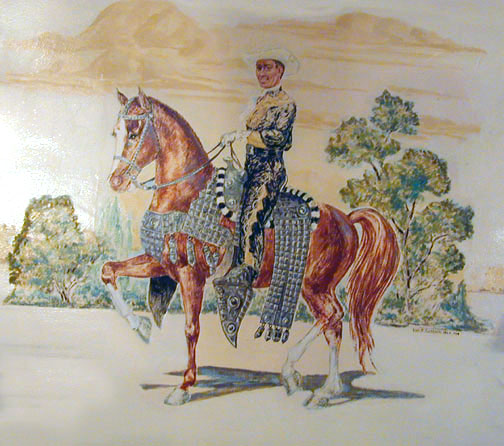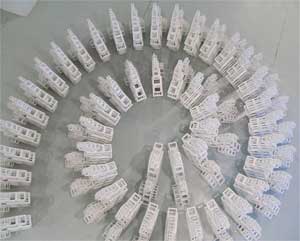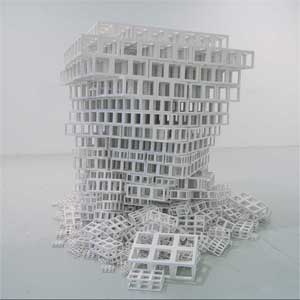Regine posts about British designer Tom Hawes’ line of skateable street furniture which, despite having come about “by recognizing skateboarding as an unstoppable urban pathology,” makes me feel good. Finally, someone’s thinking of the children.
skateable furniture [via wmmna]
On The Apprentice


So I was stoking the fires of ill will against Martha Stewart by watching the last half hour of The Apprentice, and I’m thinking, “Damn, but that woman bugs the crap out of me,” and “DAY-UM, but I hate the artificial claptrap of reality TV.” And then I decide to clear my Netflix queue by finally watching The Five Obstructions, and damned if it isn’t The Apprentice – The Lars von Trier Edition.
It’s got everything I hate to hate about reality TV: a smug, annoying, self-annointed omnipotent pseudo-god forcing a supplicant to jump through ridiculous, contrived hoops. Von Trier achieves something I never thought possible: he’s actually more annoying and passive aggressive a control freak than Stewart. [I guess Nicole Kidman and Bjork could’ve told me that; I’ll have to bring it up next time I see them.]
The twist in The Five Obstructions, of course, is that von Trier himself IS the apprentice. His mentor/inspiration/victim is the elder Danish director Jorgen Leth, who must remake his 1967 short film, The Perfect Human five times, each time acceding to von Trier’s intentionally capricious constraints [a cartoon, shot in the most miserable place on earth, no edit over 12 frames, etc.].
And just because Lars is more honest than Martha–in the end, he cops to the fact that, yeah, it IS all about him, always was–it doesn’t mean he’s any less unpleasant.
Show Me Some Penguins, Pierre
It’s supposed to keep raining through Friday, when artist Pierre Huyghe is planning to shoot an element of a new video art work in Central Park’s Wollman Rink. Huyghe is transforming the rink into a black ice floe, home for an albino penguin, apparently, and also to a 42-piece orchestra.
The public is invited to come and participate as audience/extras during three run-throughs of the piece. Even as he held out the possibility of some kind of surprise ending, Huyghe tried to manage expectations about the performance/shoot. He told Randy Kennedy of the NYT, “‘There will be no crazy dancing girls,’ he stressed. ‘In fact, there will be almost nothing – for all 20 minutes.'”
Listen, I know the guy schlepped to Antarctica for a month searching for some damn albino penguin; thanks. But if we’re gonna sit in the rain for two hours watching “almost nothing,” we better damn well see some penguins. And I’ll incite the crowd to storm the zoo if I have to.
An Antarctica Sighting in Central Park [nyt]
Buttkissing for Thumbsucking
On the occasion of the UK opening of Mike Mills’ Thumbsucker, the Observer (their Observer, that is) gives the nearly aristocratic Tilda Swinton a good, hard, philosophical fawning over:
I ask Swinton what were considered virtues in her family. She thinks for a while, then says, with an ironic smile, ‘Not drawing attention to yourself. Not expressing an opinion. Stoicism. Being a good host – something that I still stand by. I’m very grateful for that genetic programming. Being able to laugh things off – also happy to have that one. Camaraderie – you know, trench warfare. I have a brother who’s a soldier and whenever I talk to him about why he’s in the army, the things he mentions are the reasons I love making films.’ Funnily enough, Jarman once noted in his diary: ‘In my own strange way I’m in love with both Keith [his companion] and Tilda, though love is perhaps not the right word. Perhaps a camaraderie, something more military. A friendship and partnership.’
Still worth a read, though.
Tilda opens up: “Pale, posh and scarily clever…” [observer.co.uk]
Shlog-Hinten Mountain
So the new year’s not starting off that great. I found this great vintage Jewish cowboy belt buckle on ebay…
Beautiful old belt buckle has nice detail. Features the Star of David. It is intricately worked in sterling silver. The buckle is marked Plata de Jalisco .925 V.H.L.C. Guad. Mex. and also has the number 43 on the back buckle. This buckle measures aprox. 3.5″ long by 2.” Take a look. Nice from estate. Prominent Jewish family on Chicago’s north shore whom enjoyed Western style attire…ordered shirts, belts, shoes and other items from Porters Cowboy Store/Catalog Pheonix, AZ…
…but I just lost it at the last second to a hardcore Westernwear collector.
See, I wanted it for a Yiddish remake of Brokeback Mountain and uh, well, never mind. Back to the drawing board.
Previously: So You Want To Read “Brokeback Mountain”
Belt buckles I DID buy once for a movie crew
On Accepting Feedback
The sagest exegesis, however, comes from one of three short, squat, mushroom-Afro’d white teens who emerge from Royce Hall in Acid Mothers Temple T-shirts with ehhh-whatever sneers on their faces. “It’s not that I don’t like feedback,” one of them shrugs, clearly at the beginning of an aesthete’s lifelong journey of cred-proving. “It’s that I don’t like this feedback.”
Terry Riley’s birthday concert; armchair juroring Berlin’s baldfaced copy of the Turner Prize; the New Yorker Festival’s fashion panel.
It’s not all whipped cream these days at the Artforum Diary; there are some sweet berries of art experience there, too.
Deaf Jam [artforum diary]
Powersearching IMDb
The power search page of IMDb is indeed, um, powerful.
But for random delights, the filming locations browser is better.
Pimp my Searching: Internet Movie Database [sew, via rw]
Bill & Nada’s “Always Open”

Bill & Nada’s was an unassuming Salt Lake institution, a 24-hour diner [“we never close”] that sat on a downtown corner for decades, providing eggs & brains, pancakes with coconut syrup, hot coffee and a haven for folks who didn’t care for the uptight, corporate-flavored fuss of Denny’s or Village Inn.
While it’s been years since Nada passed away, Bill and his second wife ran the place until a few years ago; it closed down as giant bigbox retail stores moved into the neighborhood.
The December night Bill & Nada’s closed, I went through with my DV camera, documenting what details and ambience I could, for later reference. [I have a script somewhere about the restaurant]. I wanted to be able to recreate the counter, the booths, the big wheel, the murals [like the one above, Bill outfitted for a parade. He showed and rode horses a lot over the years.]
Far more interesting is longtime customer Bert Singleton’s Bill & Nada’s tribute website. He’s been collecting pictures of Bill & family, and of as many of the regulars at the counter as he can round up. He also has a picture of the place as it looks now. Apparently, the business that was set to take the restaurant site over never took off. Rather than being razed and erased from the map as people figured, the building has stuck around, now never open, a sad jog to the memories of the family of strangers who grew around it.
Bert’s page is always open. [billandnadas.com]
Previously: Bill & Nada’s Cafe
Who Lost Gordon Bunshaft’s Travertine House?

Modernist architect Gordon Bunshaft’s widow willed his exquisite travertine-clad Georgica Pond home–his only domestic design– and their carefully installed collection of modern art to MoMA when he died in 1994.
MoMA sold it to Martha Stewart in 1994 without any restrictions or covenants. Stewart, caught up in the Minimalist revival of the day, hired John Pawson to redo it.
Several years later the house, a gutted shambles on the brink of a poorly conceived expansion and with some of its travertine scavenged for Stewart’s Bedford, NY kitchen, was transferred to Stewart’s daughter Alexis, who put it on the market in 2004.
It sold to retro textile guy Donald Maharam, who disingenuously declared the house an unrestorable ruin and razed it in July.
The culpability compounds with each set of hands that touched this property.
Bunshaft could have put covenants on it before willing it to MoMA, but didn’t, possibly on the assumption that the Museum would, by the nature of its mission, take steps to preserve this important design.
MoMA could have put restrictions on the house when it sold it to Stewart but didn’t. MoMA’s not in the house business, so the idea that MoMA woulda shoulda kept it is naive at best. As is any idea that Bunshaft could’ve intended for MoMA to do anything but benefit from the gift of the house.
But still, the operating principles here were fiduciary, not curatorial or conservationist; and yet the “understanding” with Stewart and the publicity around it at the time, points to a perceived responsibility beyond merely maximizing the museum’s return from a donation. Q: Did the Museum set aside the proceeds from the sale for future acquisitions? “Art-for-art,” as befits a deaccession? I highly doubt it. If not, however the sale was presented–or spun– in the press, on the museum’s ledger, the house was a financial asset, not a work of art.
Stewart could have left the house as is, but didn’t. Can anyone be surprised by that? Martha Stewart is a hack. The queen of hacks. It was her penury and negligence that let the house deteriorate. She’s lucky that an over-inflated sense of your own aesthetic superiority leading to the decimation of a modernist landmark isn’t a crime, or she’d still be in jail.
Ever since the sale, MoMA said it had a “good faith agreement” with Stewart to preserve the house, which was a stripped, weed-covered shell when her lawsuits with the house’s next door neighbor were finally settled.
Pawson’s a frickin’ hack, but he coulda–no, he was just Stewart’s hack.
Alexis… this was a wealth transfer mechanism, nothing more.
Maharam’s a hack, and a spineless hack at that. He could have restored the house if he cared to, instead he hides behind the excuse that it was beyond help. The incremental expense of doing so is approximately zero compared to the price of the land. And it’s not like he can build anything else; wetlands zoning restricts him to Bunshaft’s original footprints (and whatever Stewart/Pawson managed to get approved.)
Did someone mention approvals? That’d be the East Hampton town board who sat by while one of the few interesting feats of architecture in the whole place was modified and destroyed. But then, why should important modernist design get any better treatment in the potato fields of the Hamptons than they do on the corner of Central Park?
In LA, three of Frank Lloyd Wright’s concrete block houses hover on the brink of ruin. Important corporate headquarters–including one of Bunshaft’s–get redeveloped with impunity. Modernist preservation groups like Docomomo whimper to no effect. How many 20th century landmarks must be lost before something changes?
Without any explicit agreements anywhere regarding its preservation, without any laws, zoning, landmark designations or other institutional protections, and in the face of the Hamptons real estate juggernaut, the house was doomed before Mrs. Bunshaft’s assistant ever called Frank Campbell.
I used to sail and kayak on Georgica, often with the express purpose of seeing Bunshaft’s art and the luxurious simplicity of his house. So excuse me if I seem especially pissed and despondent.
Martha’s Touch [nationaltrust.org via archinect]
Also: The Architecture Newspaper’s earlier coverage [archpaper.com, includes pic]
Disrepair At Martha’s [the easthampton star, 2002]
HC&G says MoMA chose Stewart’s bid over her Georgica neighbor, developer Harry Macklowe, on the understanding that she would do righter by the house.
[11/05 update: An earlier version of this post criticized the Preservation article as cribbed from previously published accounts of the Bunshaft house saga. This speculation was prompted by similarities in quotes and by a dangling reference to a “Krinsky,” Bunshaft’s biographer who goes otherwise unmentioned in the Preservation piece. The writer of that piece has since contacted me–presumably because I unfairly called him a hack–and provided further information that shows my purely text-based speculations were incorrect. The Krinsky thing was a copy editing oversight; and guess what, the same people talking about the same thing tend to do it in similar ways, so no surprise if their quotes sound similar.
Anyway, my apologies to the writer, an innocent bystander who got hit when I started flinging all those “hack”s around.]
Atelier Bow-Wow House, Blog
 The awesome and ingenious Tokyo architecture firm Atelier Bow-Wow (the Japanese translation, Atelier Wan, sounds nicely like “1,” too) is keeping a blog of the combination house/studio they’re building for themselves in Naka Meguro, a central, dense, and expensive section of Tokyo. The lot they found was affordable only because it’s tiny and enclosed on all sides. Still, it’s zoned for more than 660 sqm, (including underground) of live/work space.
The awesome and ingenious Tokyo architecture firm Atelier Bow-Wow (the Japanese translation, Atelier Wan, sounds nicely like “1,” too) is keeping a blog of the combination house/studio they’re building for themselves in Naka Meguro, a central, dense, and expensive section of Tokyo. The lot they found was affordable only because it’s tiny and enclosed on all sides. Still, it’s zoned for more than 660 sqm, (including underground) of live/work space.
Because of their shape–a square-ish lot blocked in and invisible from the street, and connected to it by only a narrow passageway or easement–plots like this are called flagpole sites. The site poses just the kind of severe challenges that AB-W has specialized in addressing, though.
To fit their live/work program into the envelope of the building, they have integrated and jig-sawed the home and studio spaces together, and they seem to have managed to carve out incredible space, light, privacy, and even some views on a lot that looks like something out of a Gordon Matta-Clark exhibit. Of course, it’s all in Japanese, so good luck with that excite.co.jp translator…
House & Atelier Bow-Wow [via archinect]
Tokyo House: projects for flagpole, eel, and box sites
Atelier Bow-Wow House, Blog
 The awesome and ingenious Tokyo architecture firm Atelier Bow-Wow (the Japanese translation, Atelier Wan, sounds nicely like “1,” too) is keeping a blog of the combination house/studio they’re building for themselves in Naka Meguro, a central, dense, and expensive section of Tokyo. The lot they found was affordable only because it’s tiny and enclosed on all sides. Still, it’s zoned for more than 660 sqm, (including underground) of live/work space.
The awesome and ingenious Tokyo architecture firm Atelier Bow-Wow (the Japanese translation, Atelier Wan, sounds nicely like “1,” too) is keeping a blog of the combination house/studio they’re building for themselves in Naka Meguro, a central, dense, and expensive section of Tokyo. The lot they found was affordable only because it’s tiny and enclosed on all sides. Still, it’s zoned for more than 660 sqm, (including underground) of live/work space.
Because of their shape–a square-ish lot blocked in and invisible from the street, and connected to it by only a narrow passageway or easement–plots like this are called flagpole sites. The site poses just the kind of severe challenges that AB-W has specialized in addressing, though.
To fit their live/work program into the envelope of the building, they have integrated and jig-sawed the home and studio spaces together, and they seem to have managed to carve out incredible space, light, privacy, and even some views on a lot that looks like something out of a Gordon Matta-Clark exhibit. Of course, it’s all in Japanese, so good luck with that excite.co.jp translator…
House & Atelier Bow-Wow [via archinect]
Tokyo House: projects for flagpole, eel, and box sites
John Powers-a-Day at Virgil de Voldere Gallery


When I first met John Powers five+ years ago, he was like a Tibetan monk with a pile of sand. Only instead of sand, he had thousands of 1-inch woodblocks, which he transformed into a huge, impossibly intricate, mandala-like sculpture that sprawled across the floor of Exit Art’s gallery. Every day throughout the exhibit, he scooted around on a little skateboard chair, replicating and altering dense patterns of blocks as he went. The work wasn’t “finished” when the show ended, and he swept the whole thing away, but that, I think was part of the point.
Now, in his latest show at Virgil de Voldere Gallery in the Chelsea Arts Building, Powers is reconfiguring hundreds? thousands? of white, Sol Lewitt-like grid modules into a new sculpture every day. The gallery’s website has pictures of the ones you’ve missed, but you can also stop by until Oct. 9th to watch new pieces come together.
John Powers at Virgil de Voldere through Sun., Oct. 9 [virgilgallery.com]
John Powers-a-Day at Virgil de Voldere Gallery


When I first met John Powers five+ years ago, he was like a Tibetan monk with a pile of sand. Only instead of sand, he had thousands of 1-inch woodblocks, which he transformed into a huge, impossibly intricate, mandala-like sculpture that sprawled across the floor of Exit Art’s gallery. Every day throughout the exhibit, he scooted around on a little skateboard chair, replicating and altering dense patterns of blocks as he went. The work wasn’t “finished” when the show ended, and he swept the whole thing away, but that, I think was part of the point.
Now, in his latest show at Virgil de Voldere Gallery in the Chelsea Arts Building, Powers is reconfiguring hundreds? thousands? of white, Sol Lewitt-like grid modules into a new sculpture every day. The gallery’s website has pictures of the ones you’ve missed, but you can also stop by until Oct. 9th to watch new pieces come together.
John Powers at Virgil de Voldere through Sun., Oct. 9 [virgilgallery.com]
George Bush Defends Kate Moss
Rang dang diggity dang-de-dang…
Just when you think this remix of George W. Bush covering “White Lines” couldn’t get any better, comes this line about two minutes in:
Some a**hole took a picture
of Kate Moss doing lines,
And now she’s being victimized
for imaginary crimes
White Lines, sung by a guy who knows [thepartyparty via waxy]
George Bush Defends Kate Moss
Rang dang diggity dang-de-dang…
Just when you think this remix of George W. Bush covering “White Lines” couldn’t get any better, comes this line about two minutes in:
Some a**hole took a picture
of Kate Moss doing lines,
And now she’s being victimized
for imaginary crimes
White Lines, sung by a guy who knows [thepartyparty via waxy]
